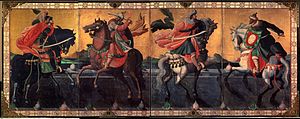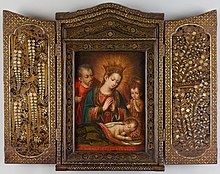Nanban art



Nanban art (南蛮美術) refers to Japanese art of the sixteenth and seventeenth centuries influenced by contact with the Nanban (南蛮) or 'Southern barbarians', traders and missionaries from Europe and specifically from Portugal. It is a Sino-Japanese word, Chinese Nánmán, originally referring to the peoples of South Asia and Southeast Asia. During the Nanban trade period, the word took on a new meaning when it came to designate the Portuguese, who first arrived in 1543, and later other Europeans. The term also refers to paintings which Europeans brought to Japan.[3][4]
History[edit]
Nanban art developed after the first Portuguese ships arrived in Kyushu in 1543. While Christian icons and other objects were produced, Nanban byōbu (南蛮屏風) or folding screens are particularly notable, with over 90 pairs surviving to this day.[1] These vibrant paintings depicted foreigners of all colors arriving in Japanese ports and walking in the streets of Japanese inland towns[5] (see figure 1). Another popular subject within Nanban art was the depiction of foreign warriors. Artists of the Kanō school were joined by those of the Tosa school in combining foreign subject matter with Japanese styles of painting. Canons of western art of the period, such as linear perspective and alternative materials and techniques, appear to have had little lasting influence in Japan. Given the persecution and prohibition of Christianity from the end of the sixteenth century and the Tokugawa policy of sakoku, which largely closed Japan to foreign contact from the 1630s, Nanban art declined. [3][6]
-
Painting from Momoyama period (1573-1615) by Hasegawa Nobukata of a European woman playing a viola de mano.
-
Hasegawa Nobukata painting of a religious man with children. Edo period, early 17th century.
-
Screen painting of foreign ship and Europeans in Japan.
-
Hasegawa Nobukata painting of two "Western warriors." Edo period, early 17th century.
-
Namban art, screen painting, circa 1600.
Reverse influence[edit]
While Japonism did not develop in the west until after the reopening of Japan in the 1850s and the 1860s, there is evidence of earlier Japanese influence in the art of Colonial Mexico. Japanese lacquerware influenced pre-Hispanic lacquerware resulting in Mexican lacquerware or maque, from Japanese makie. This was derived from the trade in Japanese crafts through the Manila Galleons, which traveled between Manila (Philippines) to Acapulco (Mexico) from 1565 to 1815.[7]
Museums with collections of Nanban art[edit]
- Kobe City Museum[8]
- Museu Nacional de Arte Antiga[9]
- Museu do Oriente, Lisbon
See also[edit]
References[edit]
- ^ a b 南蛮屏風 Kobe City Museum
- ^ 泰西王侯騎馬図 Kobe City Museum
- ^ a b Okamoto, Yoshitomo (1972). The Namban Art of Japan. Weatherhill. ISBN 0-8348-1008-5.
- ^ "Nanban-e". Japanese Architecture and Art Net Users System. Retrieved 28 March 2011.
- ^ Testa, Giuseppina Aurora (2020-07-03). ""Mōko Shūrai Ekotoba" (Illustrated Account of the Mongol Invasions)". Eikón / Imago. 9: 35–57. doi:10.5209/eiko.73275. ISSN 2254-8718.
- ^ "Nanban-byoubu". Japanese Architecture and Art Net Users System. Retrieved 28 March 2011.
- ^ Lake, Rodrigo Rivero (2006). Namban: Art in Viceregal Mexico. Turner. ISBN 978-84-7506-693-6.
- ^ "Kobe City Museum e-guide" (PDF). Kobe City. Retrieved 28 March 2011.
- ^ "Biombos Namban (Namban screens)". Museu Nacional de Arte Antiga. Archived from the original on 20 May 2011. Retrieved 28 March 2011.
bibliography
(en) Alexandra Curvelo, Nanban Folding Screen Masterpieces, Chandeigne, 2015 (978-2-36732-121-9)
(pt) Alexandra Curvelo, Obras-primas dos biombos Nanban, Japão-Portugal século XVII, Chandeigne, 2015 (ISBN 978-2-36732-120-2)





